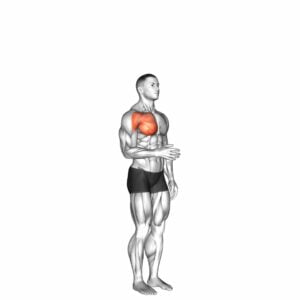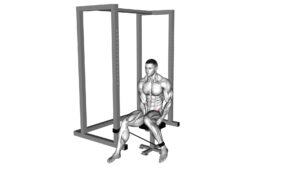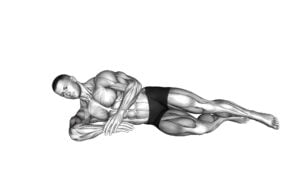Hip – Medial Rotation (Internal Rotation) – Video Exercise Guide & Tips

Looking to improve your hip medial rotation? This video exercise guide and tips will show you how!
Watch This Exercise Video
Discover the benefits of hip medial rotation exercises, learn warm-up exercises to prepare your muscles, and strengthen and stretch your hip for improved flexibility and mobility.
With proper technique and progression, you'll be on your way to achieving better hip rotation in no time.
Let's get started!
Key Takeaways
- Regularly incorporating hip medial rotation exercises improves flexibility and strength of the muscles involved.
- Hip medial rotation exercises enhance overall performance and reduce the risk of injuries such as hip impingement and hip labral tears.
- Performing warm-up exercises before hip medial rotation workouts increases hip mobility and prevents injuries.
- Proper technique, gradual progression, and listening to your body are important when performing hip medial rotation exercises.
Benefits of Hip Medial Rotation Exercises
You should regularly incorporate hip medial rotation exercises into your fitness routine to experience the numerous benefits they offer. The importance of hip mobility can't be overstated, as it plays a crucial role in various movements, such as walking, running, and even sitting. By focusing on hip medial rotation exercises, you can improve the flexibility and strength of the muscles involved in this movement, which can enhance your overall performance and reduce the risk of injuries.
One common injury related to hip medial rotation is hip impingement. This occurs when the hip joint becomes compressed or pinched, leading to pain and limited range of motion. By regularly incorporating exercises that target hip medial rotation, you can help prevent hip impingement by maintaining proper joint alignment and strengthening the surrounding muscles.
Another common injury is a hip labral tear, which refers to a tear in the cartilage that lines the hip joint. This can cause pain, clicking, and instability in the hip. By improving hip medial rotation, you can help stabilize the hip joint and reduce the risk of labral tears.
Warm-Up Exercises for Hip Medial Rotation
To prepare for hip medial rotation exercises, begin with a series of warm-up exercises. Warm-up exercises are essential for increasing hip mobility and preventing injuries. Before you start your workout, take a few minutes to loosen up and prepare your hips for the movements ahead.
One effective warm-up exercise for hip medial rotation is the seated hip internal rotation stretch. Sit on the edge of a chair and cross one ankle over the opposite knee. Gently press down on the raised knee with your hand to increase the stretch. Hold for 30 seconds and then switch sides.
Another great warm-up exercise is the standing hip internal rotation stretch. Stand upright and cross one foot over the opposite knee. Slowly lower your body down into a single-leg squat while keeping your back straight. Hold the position for 30 seconds and then switch sides.
Performing these warm-up exercises will help improve your hip mobility and prepare your muscles for the medial rotation exercises. By incorporating these warm-up exercises into your routine, you can reduce the risk of injury and maximize the benefits of your hip medial rotation workout.
Remember to listen to your body and only perform exercises that are within your comfort level.
Strengthening Exercises for Hip Medial Rotation
To strengthen your hip medial rotation, incorporate specific exercises that target the muscles involved in this movement. Standing exercises are a great way to engage these muscles and improve their strength.
One effective exercise is the standing internal rotation. To do this exercise, stand with your feet shoulder-width apart and place a resistance band around your thighs, just above your knees. Keeping your hips and knees slightly bent, slowly rotate your right leg inward, against the resistance of the band. Hold this position for a few seconds, then return to the starting position. Repeat on the other side.
Another standing exercise is the standing cable internal rotation. Attach a cable to ankle height on a cable machine and stand sideways to the machine. With your outer leg, pull the cable towards your body, rotating your leg inward. Slowly return to the starting position and repeat on the other side.
Seated exercises can also help strengthen your hip medial rotation. One option is the seated internal rotation. Sit on a chair or bench with your knees bent and feet flat on the ground. Place a resistance band around your thighs, just above your knees. Keeping your feet planted, slowly rotate your right leg inward, against the resistance of the band. Hold for a few seconds, then return to the starting position. Repeat on the other side.
Another seated exercise is the seated cable internal rotation. Sit on a chair or bench facing a cable machine. Attach a cable to ankle height and place your outer leg against the cable. Pull the cable towards your body, rotating your leg inward. Slowly return to the starting position and repeat on the other side.
Incorporating these standing and seated exercises into your workout routine will help strengthen your hip medial rotation muscles and improve your overall hip flexibility and stability.
Stretching Exercises for Hip Medial Rotation
Incorporate specific stretching exercises to improve the flexibility and range of motion in your hip medial rotation. Hip medial rotation is important for athletes as it allows for efficient movement and helps prevent injuries. When the hip lacks medial rotation, athletes are at a higher risk of experiencing common injuries such as hip impingement, hip bursitis, and hip labral tears.
Stretching exercises for hip medial rotation can help alleviate these risks and improve athletic performance. One effective stretch is the seated hip internal rotation stretch. To perform this stretch, sit on the edge of a chair or bench with one ankle crossed over the opposite knee. Gently apply pressure to the crossed leg, pushing it downward and feeling a stretch in the hip. Hold this position for 30 seconds and repeat on the other side.
Another beneficial stretch is the supine hip internal rotation stretch. Lie on your back with your knees bent and feet flat on the ground. Allow one knee to fall out to the side while keeping the other foot planted on the ground. Use your hand to gently push the knee towards the ground, feeling a stretch in the hip. Hold for 30 seconds and then repeat on the other side.
Incorporating these stretching exercises into your routine can help improve your hip medial rotation and reduce the risk of injuries associated with its lack. Remember to perform these stretches regularly and consult with a healthcare professional if you experience any pain or discomfort.
Tips for Proper Technique and Progression
Improve your hip medial rotation and prevent injuries by focusing on proper technique and progression.
When performing hip medial rotation exercises, it's important to maintain proper form to maximize the benefits and minimize the risk of injury.
One common mistake is using momentum to initiate the movement instead of relying on the muscles responsible for hip internal rotation. To avoid this, start the movement by consciously engaging the muscles in your hip and control the motion throughout.
Another common mistake is allowing the rest of your body to move during the exercise, such as twisting your torso or lifting your shoulders. To maintain proper form, keep your upper body stable and focus solely on the rotation happening at the hip joint.
As you progress with your hip medial rotation exercises, gradually increase the difficulty by using resistance bands or adding weights. This will help to further strengthen the muscles involved and improve your overall hip mobility.
Remember to always listen to your body and start with lighter resistance or lower weights before progressing to more challenging levels.
Frequently Asked Questions
How Often Should I Perform Hip Medial Rotation Exercises?
To get the benefits of hip medial rotation exercises, you should perform them regularly. The frequency depends on your goals and fitness level. Generally, it's recommended to do these exercises two to three times a week.
Make sure to properly perform the movements by engaging the hip muscles and avoiding any pain or discomfort.
Consistency and proper form are key to seeing improvements in your hip medial rotation strength and flexibility.
Are There Any Modifications for People With Hip Injuries or Conditions?
If you have a hip injury or condition, there may be modifications you can make to the hip medial rotation exercises. These modifications can help ensure that you don't exacerbate your injury or worsen your condition.
It's important to consult with a healthcare professional or a physical therapist who can provide you with specific modifications tailored to your needs. They can guide you on how to perform the exercises safely and reap the benefits without causing harm.
Can Hip Medial Rotation Exercises Help With Lower Back Pain?
Hip medial rotation exercises can indeed help with lower back pain. By improving the flexibility of your hips, these exercises can relieve tension and stress in your lower back.
Additionally, hip medial rotation exercises also have a positive impact on core stability. Strengthening the muscles around your core can provide support and stability to your lower back, reducing the risk of pain and injury.
Incorporating these exercises into your routine can contribute to a healthier, pain-free lower back.
Are There Any Precautions I Should Take Before Starting These Exercises?
Before starting these exercises, it's important to take some precautions.
Make sure to warm up your body and stretch properly to prevent injury.
If you have any previous hip or lower back injuries, consult with a healthcare professional to determine if these exercises are suitable for you.
It's also important to listen to your body and modify any movements that cause pain or discomfort.
How Long Does It Usually Take to See Results From Hip Medial Rotation Exercises?
Usually, it takes a few weeks to see results from hip medial rotation exercises. Consistency is key. By regularly performing these exercises, you can improve your hip mobility and flexibility.
The benefits of hip medial rotation exercises include strengthening the muscles in your hip joint and improving your overall hip stability.
Some of the best hip medial rotation exercises include:
- Seated hip internal rotation stretch
- Supine hip internal rotation stretch
- Standing hip internal rotation stretch.
Conclusion
In conclusion, hip medial rotation exercises are beneficial for improving mobility and strength in the hip joint.
By incorporating warm-up exercises, strengthening exercises, and stretching exercises, individuals can enhance their hip medial rotation range of motion and reduce the risk of injuries.
It's important to maintain proper technique and gradually progress in intensity to ensure optimal results.
Keep up with these exercises to support overall hip health and enhance athletic performance.

Author
Years ago, the spark of my life’s passion ignited in my mind the moment I stepped into the local gym for the first time. The inaugural bead of perspiration, the initial endeavor, the very first surge of endorphins, and a sense of pride that washed over me post-workout marked the beginning of my deep-seated interest in strength sports, fitness, and sports nutrition. This very curiosity blossomed rapidly into a profound fascination, propelling me to earn a Master’s degree in Physical Education from the Academy of Physical Education in Krakow, followed by a Sports Manager diploma from the Jagiellonian University. My journey of growth led me to gain more specialized qualifications, such as being a certified personal trainer with a focus on sports dietetics, a lifeguard, and an instructor for wellness and corrective gymnastics. Theoretical knowledge paired seamlessly with practical experience, reinforcing my belief that the transformation of individuals under my guidance was also a reflection of my personal growth. This belief holds true even today. Each day, I strive to push the boundaries and explore new realms. These realms gently elevate me to greater heights. The unique combination of passion for my field and the continuous quest for growth fuels my drive to break new ground.







